
The ceramics from the Knecht pottery in CERAMICA CH
Roland Blaettler, 2019
In 1822, Henry-Arnold Knecht (1802-1878) from Wald (Canton of Zurich), started work at the Braissant pottery in Ferney-Voltaire in France. Having married the daughter of the owner, he became his successor in 1827 (Clément 2000, 77). In 1855 the Geneva authorities granted him residency, which allowed him to open a regional branch on Genevan territory. His son Lucien (1837-1890) settled in Colovrex and became a citizen of Geneva in 1872 (Clément 2000, 79). After his father’s death in 1878, Lucien took over management of both workshops, though it was not until 28th March 1883 that he was listed in the Swiss Official Gazette of Commerce (SOGC) as director of the company “L. Knecht à Colovrex-Bellevue” (Vol. 1, 1883, 496), presumably because until then, the Geneva business had still been considered a branch of Ferney-Voltaire.
In December 1890, one day after Lucien’s death, his widow Marie-Jeanne, née Dailledouze (died in 1905), together with her three sons, Arnold (1862-1921), Stanislas (1863-1941) and Louis (1870-1952), formed a partnership under the name “Veuve Knecht & ses fils” (The widow Knecht and her sons). The business had its headquarters in Colovrex and a branch in Ferney. Its field of expertise was described as “pottery making and stove setting, production of drainpipes and tiles” (SOGC, Vol. 9, 1891, 459).
The partnership was dissolved in 1905 following Marie-Jeanne’s death, and the three sons set up a new company called “Knecht frères”. Louis lived in Colovrex, Stanislas and Arnold in Ferney (SOGC Vol. 23, 1905, 222). Arnold left the company in 1914 (SOGC, Vol. 32, 1914, 597).
From 31st December 1926 onwards, the two branches went their separate ways, at least legally: the company name “Knecht frères” was struck off the register, with Stanislas (or perhaps his son Robert? – see Clément 2000, 79) taking over the Ferney branch and Louis carrying on the Colovrex business under the name “Louis Knecht”, producing “all kinds of utilitarian pottery, architectural ceramics, chimney flues, chimney cowls and drainpipes” (SOGC, Vol. 45, 1927, 211).
In 1954, the Geneva business was taken over by Georges Knecht (1906–1982) (SOGC, Vol. 72, 1954, 2456). He continued production until shortly before his death, and in May 1983, the company name was struck off by the authorities “due to death and cessation of the business” (SOGC, Vol. 101, 1983, 1818).
The workshop in Ferney was latterly run by Robert Knecht (1897-1951), and then by his widow. In 1958 the company closed its doors for the last time (Clément 2000, 79).
The French and Swiss enterprises run by the Knecht family largely produced the same vessel shapes, mainly in slipped and glazed earthenware.

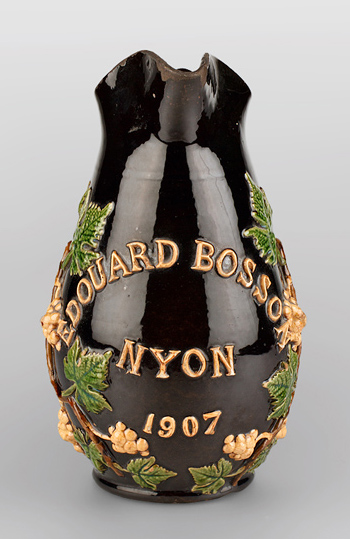
The Colovrex branch of the family advertised its products far and wide, from the Geneva region to the Neuchâtel Jura and even as far afield as the Canton of Solothurn (as far as we have been able to determine), with the most characteristic types at the end of the 19th and the first half of the 20th centuries being the so-called “welcoming jugs” or patriotic jugs with applied decoration consisting of vine leaves and the coats of arms of the Cantons of Vaud, Neuchâtel and Bern (MHL 0170 MH; MLS 240001; MHPN MH-2015-9; MHPN MH-2015-8; MHPN MH-1998-113; MHPN MH-2014-10; MHPN MH-FA-10018A; MHPN MH-2015-187; MHPN MH-1998-299; MHPN MH-2012-64; MVVE 2411; MVVE 2355).
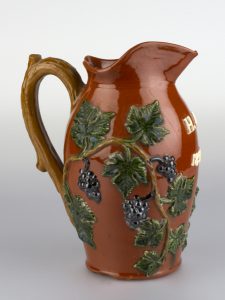
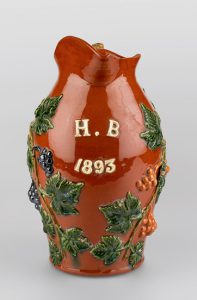
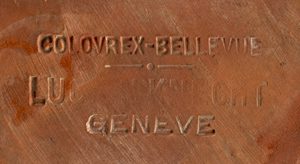
The Musée historique et des porcelaines (Historical and Porcelain Museum) in Nyon houses the only two marked examples that are known to have survived: one has a stamped, impressed mark that reads “Lucien Knecht – Colovrex-Bellevue Genève” (MHPN MH-2015-9), and is dated 1893, while the other bears the mark “Knecht Frères – Colovrex-Bellevue Genève” (MHPN 2014-10) and is dated 1905. The impressed mark on the first jug suggests that Lucien’s widow continued to use his mark even after his death in 1890. Some examples of the same type have been attributed to the Ferney workshop (Ferney-Voltaire 1984, 294 and 297; Clément 2000, 83).

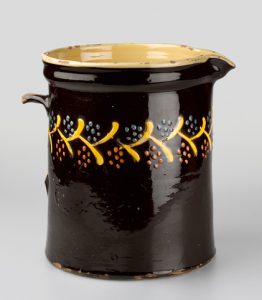
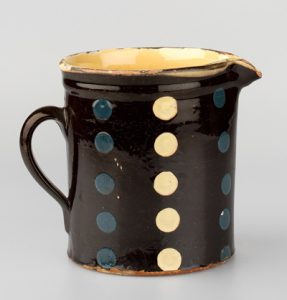
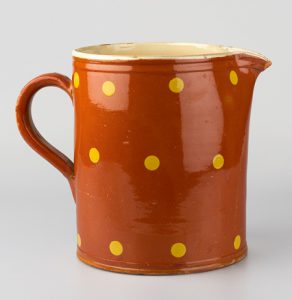
Another type of vessel, which was very popular around the same time and in the same area, was a cylindrical milk jug with a thickened and concave rim and schematic decoration consisting of floral or geometric motifs (MRVT No. 67; MRVT No. 68; MRVT BR 4a; MRVT BR 4; MPA 914; MPA Bv 4; MPA Bv 15; MPA Bv 12; MPA Bv 5; MWH H 2523; MWH H 2563; MVVE ; MVB No. 1; MPE No. 8).
Jugs like these are known to have been produced at Colovrex until the mid-1950s (De Freire de Andrade and de Chastonay 1956, Fig. 5). The Georges Amoudruz collection at the Musée d’ethnographie (Anthropological Museum) in Geneva houses a large number, most of which are attributed to Colovrex. The collection also contains several commemorative jugs of the same shape with dates from between 1914 and 1967 (for example ).
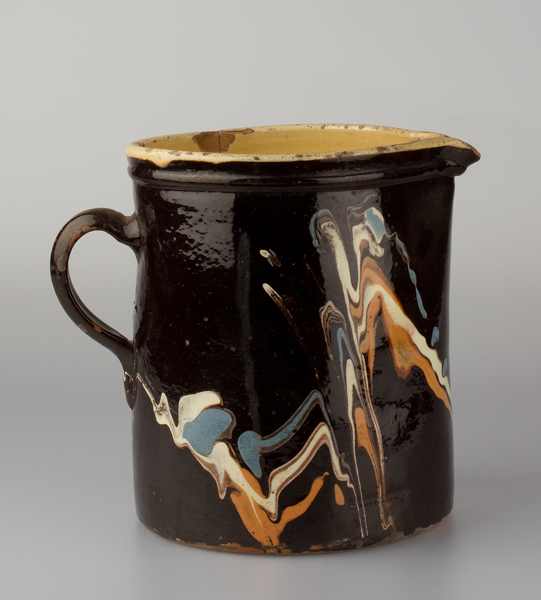
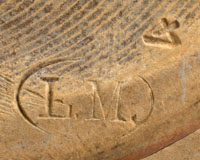
However, the same or similar types of vessel were also produced by many other workshops, particularly at Renens (Vaud – MRVT No. 26) and in neighbouring France (Savoie, Ain – see e.g. Lahaussois and Pannequin 1996, 82; Sèvres 1999, 122-126; Clément 2000, 80-81; Dufournet 1979, Fig. 5-9, 16, 17-19, 22). It should be noted that French potters would have called this type of vessel a “Jura jug” (Dufournet 1979, 298).
It is very difficult to ascertain how many of these vessels were made by the Knecht potters, as none of them clearly bears the hallmarks of the Knecht style – at least as far as we can tell today. The same applies to the vast array of utilitarian wares, largely undecorated, that can be found throughout the French-speaking part of Switzerland (e.g. MM 1014; MM 920; MPE 2938; MHL AA.VL 90 C 690; MVB 380B; MVM M 203). While all these shapes were indeed made by the Knechts (see a pricelist of the Knecht company for Ferney and Colovrex with drawings of the shapes, late 19th to early 20th centuries: Clément 2000, 82), they were not the only ones! In such cases we have not made any specific attributions and have instead used the umbrella term “pottery from the region of Lake Geneva”.
Siehe «Région lémanique, les poteries engobées (Ende 19. bis 20. Jahrhundert)».
References:
Blaettler/Ducret/Schnyder 2013
Roland Blaettler/Peter Ducret/Rudolf Schnyder, Ceramica CH. Inventaire national de la céramique dans les collections publiques suisses, 1500-1950, t. I: Neuchâtel. Sulgen 2013, 202.
Buttin/Pachoud-Chevrier/Faÿ-Hallé 2007
Anne Buttin/Michèle Pachoud-Chevrier/Antoinette Faÿ-Hallé, La Poterie domestique en Savoie, Annecy 2007.
Clément 2000
Alain Clément, La poterie de Ferney: deux siècles d’artisanat. Yens-sur-Morges/Saint-Gingolph 2000.
De Freire de Andrade et de Chastonay 1956
Nadège de Freire de Andrade et de Philibert Chastonay, La dernière poterie rustique genevoise. Archives suisses d’anthropologie générale, XXI, 1956, 8-141.
Dufournet 1979
Paul Dufournet, Les ateliers frères de poterie de Vanzy (Haute-Savoie) et de Vanchy (Ain). In: Le Monde alpin rhodanien. Revue régional d’ethnologie 1-4. Artisanat et métiers de tradition, 281-316.
Ferney-Voltaire 1984
Ferney-Voltaire. Pages d’histoire. Ferney-Voltaire/Annecy 1984.
Lahaussois et Pannequin 1996
Christine Lahaussois et Béatrice Pannequin, Terres vernissées, sources et traditions. Paris 1996.
Sèvres 1999
L’art de la terre vernissée, du Moyen Age à l’an 2000, cat. d’exposition, Sèvres/Arras, Musée national de céramique/Musée des beaux-arts. Paris 1999.

